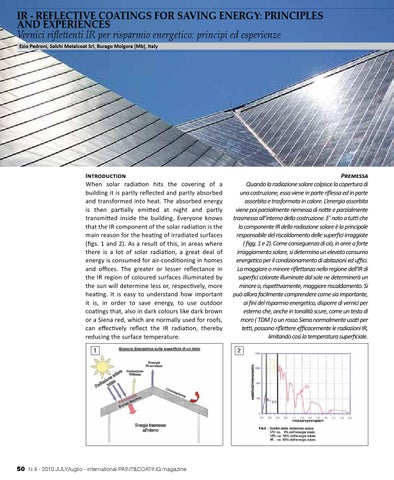IR - REFLECTIVE COATINGS FOR SAVING ENERGY: PRINCIPLES AND EXPERIENCES Vernici riflettenti IR per risparmio energetico: principi ed esperienze Ezio Pedroni, Salchi Metalcoat Srl, Burago Molgora (Mb), Italy
Introduction When solar radiation hits the covering of a building it is partly reflected and partly absorbed and transformed into heat. The absorbed energy is then partially emitted at night and partly transmitted inside the building. Everyone knows that the IR component of the solar radiation is the main reason for the heating of irradiated surfaces (figs. 1 and 2). As a result of this, in areas where there is a lot of solar radiation, a great deal of energy is consumed for air-conditioning in homes and offices. The greater or lesser reflectance in the IR region of coloured surfaces illuminated by the sun will determine less or, respectively, more heating. It is easy to understand how important it is, in order to save energy, to use outdoor coatings that, also in dark colours like dark brown or a Siena red, which are normally used for roofs, can effectively reflect the IR radiation, thereby reducing the surface temperature. 1
50 N.4 - 2010 JULY/luglio - international PAINT&COATING magazine
Premessa Quando la radiazione solare colpisce la copertura di una costruzione, essa viene in parte riflessa ed in parte assorbita e trasformata in calore. L’energia assorbita viene poi parzialmente riemessa di notte e parzialmente trasmessa all’interno della costruzione. E’ noto a tutti che la componente IR della radiazione solare è la principale responsabile del riscaldamento delle superfici irraggiate ( figg. 1 e 2). Come conseguenza di ciò, in aree a forte irraggiamento solare, si determina un elevato consumo energetico per il condizionamento di abitazioni ed uffici. La maggiore o minore riflettanza nella regione dell’IR di superfici colorate illuminate dal sole ne determinerà un minore o, rispettivamente, maggiore riscaldamento. Si può allora facilmente comprendere come sia importante, ai fini del risparmio energetico, disporre di vernici per esterno che, anche in tonalità scure, come un testa di moro ( TDM ) o un rosso Siena normalmente usati per tetti, possano riflettere efficacemente le radiazioni IR, limitando così la temperatura superficiale. 2
